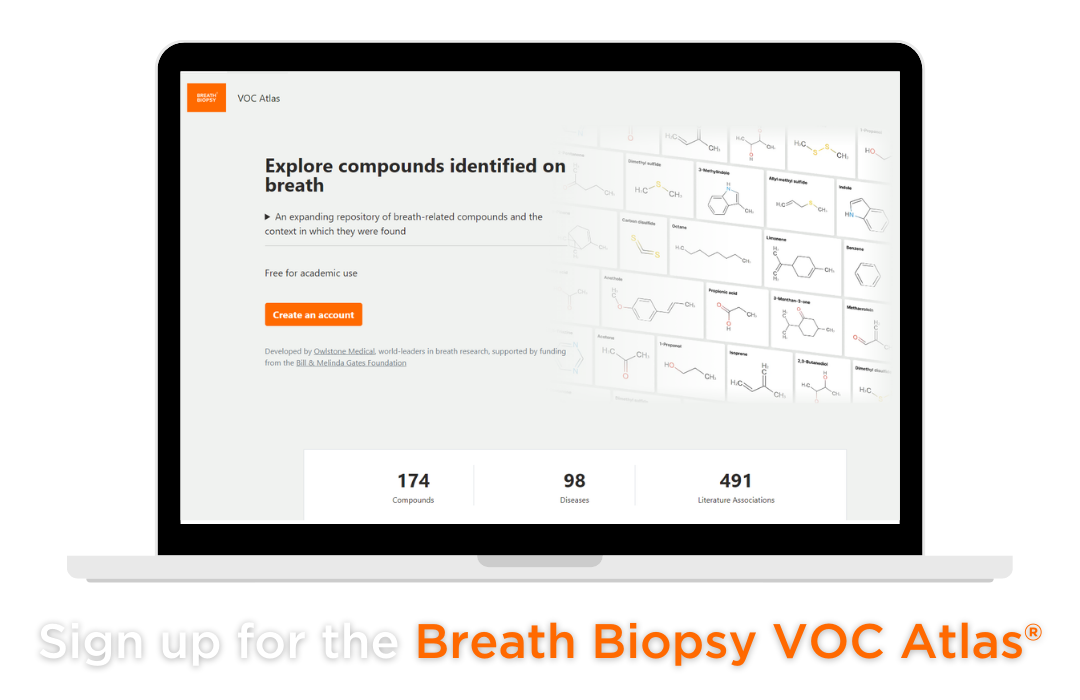Delve into our VOC Atlas: Interview with Matteo Tardelli
Published on: 20 Sep 2024

For this Owlstone Insights blog article, we spoke to Dr. Matteo Tardelli, a Senior Biomarker Scientist here at Owlstone Medical. Matteo discusses our soon-to-release Breath Biopsy VOC Atlas®. To access to the Atlas, sign in here.
Can you tell us about your background and why you chose to research breath?
Certainly! My background spans over 13 years in translational and clinical research, particularly in biomarker discovery and translational science across various diseases, including rare cancers, metabolic disorders, and immunology. My journey into breath research began when I joined Owlstone Medical, where I was drawn to the innovative approach of using breath analysis for disease detection. Breath research intrigued me because it offers a non-invasive way to monitor and diagnose diseases, which can revolutionize patient care. The idea of using volatile organic compounds (VOCs) as biomarkers for early detection and precision medicine aligns with my passion for improving patient outcomes by understanding complex diseases.
What is the VOC Atlas and why is it being developed?
The VOC Atlas is a comprehensive and expanding reference database of chemically identified and confirmed volatile organic compounds found in human breath. It is being developed to serve as a robust resource for identifying and validating disease-associated VOCs. The goal is to provide a standardized resource that researchers and clinicians can use to compare breath samples, facilitating the identification of biomarkers that are indicative of specific diseases. By building this atlas, we aim to streamline the process of discovering new biomarkers and enhance the accuracy of breath-based diagnostics.
Julia Greenwood from Owlstone Medical recently presented at the Breath Biopsy Conference 2024, on ‘Volatile Biomarker Discovery and the VOC Atlas’. You can catch up on Julia’s talk as well as the other presentations from the conference here.
How were you able to chemically identify the VOCs found in human breath?
Identifying VOCs in human breath is a meticulous process that involves advanced analytical techniques such as gas chromatography-mass spectrometry (GC-MS). At Owlstone Medical, we use our proprietary Breath Biopsy® technology to collect breath samples non-invasively. The collected breath samples are then analyzed using gold-standard high-resolution accurate mass TD-GC-MS to separate and identify the chemical compounds present. Our team of scientists applies stringent criteria to verify the identity of each VOC in accordance with MSI standards, ensuring that only chemically confirmed compounds are included in the VOC Atlas. This process allows us to create a reliable and accurate database of VOCs that can be used for further research and clinical applications.
When it comes to validating disease-associated VOCs in breath – how can the VOC Atlas help with this in the future?
The VOC Atlas could play a crucial role in the validation of disease-associated VOCs by providing a reference point for comparing VOC data from breath samples. Researchers can use the Atlas to match the VOCs found in patient samples with those already present in the literature, as well as those identified and confirmed with higher confidence in our internal and customer studies. This comparison will help in determining whether specific VOCs are associated with certain diseases. In the future, as the Atlas continues to expand, it will enable faster and more accurate validation of new biomarkers, ultimately leading to the development of breath-based diagnostic tests that can detect diseases at an earlier stage, with greater precision. Check out our recently published paper, where we discuss the framework behind developing the VOC Atlas.
We are soon to release a part of the Atlas to external researchers – can you tell us a bit about that?
Releasing a ‘preview’ of the VOC Atlas to the external research community is a significant step in fostering collaboration and accelerating discoveries in breath research. By providing access to this database, we empower other scientists to explore the potential of VOCs in their own studies. This open-access approach not only facilitates the validation of our findings but also encourages the discovery of new VOCs that may be linked to different diseases. Sharing this resource with the broader research community helps in building a more comprehensive understanding of the role VOCs play in human health and disease. You can sign up for access to the VOC Atlas when it becomes available.
What are the next steps of the Atlas project?
The next steps for the VOC Atlas project include expanding the database to cover a wider range of VOCs from varied populations and clinical conditions. We aim to collaborate with more researchers to enrich the diversity and depth of the studies included. Additionally, we plan to incorporate more literature and disease associations, such as those related to infections and metabolic disorders, while maintaining high curation standards. We will also enhance data analytics to improve identification and validation processes. Our ultimate goal is to establish the VOC Atlas as a global benchmark in breath-based diagnostics, leading to innovative tools for routine clinical use and improved patient care.
